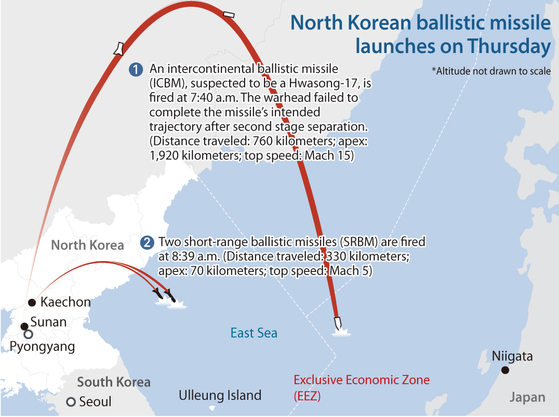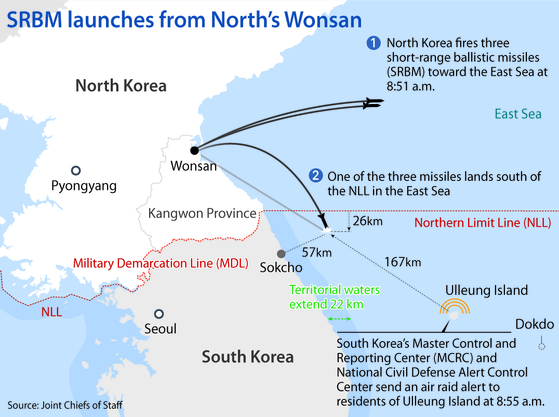Nov. 2, 2022
North Korea launched four short-range ballistic
missiles (SRBMs) into the Yellow Sea at 6:51 a.m.(KST) from Chongju and
Pihyon in North Pyongan Province, followed by three SRBMs into the East
Sea at 8:51 a.m. from Wonsan, Kangwon Province. One of those three SRBMs landed
in the South of the Northern Limit Line (NLL), which serves as the de facto
inter-Korean maritime border. The SRBM landed in the sea 167 kilometers
northwest of the island but only 57 kilometers northeast of the South Korean
coastal city of Sokcho and 34 kilometers outside the South's territorial
waters. This is the first time North Korea has fired a missile toward South
Korean territory.
At 9:12 a.m., North Korea fired an additional 10
suspected surface-to-air missiles into the East Sea from Nakwon, Chongpyong, and Sinpo in South Hamgyong Province and into the Yellow Sea from Onchon and
Hwajin-ri in South Pyongan and Kwa-il in South Hwanghae Province.
From 11:10 a.m., in response to the North's provocations,
South Korea's F-15K and KF-16 warplanes fired three precision strike
air-to-surface SLAM-ER missiles into high seas north of the NLL.
Around 1:27 p.m., North Korea fired more than 100
artillery shells from Kosong area, Kangwon Province, into the eastern maritime
buffer zone. The buffer zone was set under the 2018 inter-Korean military agreement.
From 4:30 p.m. to 5:10 p.m., Pyongyang fired 6 more
missiles, including suspected surface-to-air ones, into the East and Yellow
Seas.
South Korea and the U.S. started a large joint air
exercise dubbed Vigilant Storm on Oct. 31, mobilizing more than 240 aircraft, including F-35A stealth fighters from the South Korean Air Force and F-35B, U-2
from the U.S. military. North Korea blasted it and threatened to take "all necessary measures" in response.
(source: Korea Joongang Daily, Korea Joongang Daily, Yonhap News)
 |
ground, air, sea buffer zone(no hostile action) agreed by two Koreas in 2018 |
Nov. 3, 2022
At around 7:40 a.m., North Korea fired ICBM,
believed by experts to be a Hwasong-17 type, from the Sunan area near Pyongyang.
It flew about 760 kilometers, peaking at an altitude of approximately 1,920km
and reaching a top speed of Mach 15, according to South Korea's Joint
Chiefs of Staff. Although second-stage separation did occur, the detached
warhead failed to maintain its intended trajectory and splashed into the East
Sea just outside South Korea's exclusive
economic zone around 8:10.
At around 8:39 a.m., North Korea fired two short-range
ballistic missiles from Kaechon in South Pyongan Province. The missiles
traveled approximately 330 kilometers, reaching a maximum altitude of around 70
kilometers and a top speed of Mach 5.
In response to North Korea's firing of an ICBM, South
Korea and the United States have agreed to hold joint air drills, Vigilant
Storm, through by Oct. 5. In the wake of the announcement of the decision to
extend the drills, the North shot three additional SRBMs into the East
Sea between around 9:35 p.m. and 9:49 p.m.(KST) from Koksan County in North
Hwanghae Province. It flew approximately 490km, reaching a maximum altitude of
around 130km and a top speed of Mach 6.
At around 11:28 p.m., North Korea fired about 80 artillery shells into the military buffer zone in the East Sea from Keumgang, Kangwon Province, violating the 2018 agreement with South Korea designed to reduce military tension. (source: Korea Joongang Daily, Yonhap News)
 |
(source: Korea Joongang Daily) |
Nov. 4, 2022
Nov. 5, 2022
North Korea fired four short-range ballistic missiles (SRBMs) toward the Yellow Sea from Tongrim County in North Pyongan Province between around 11:32 a.m. and 11:59 a.m.(KST) The missiles flew about 130 kilometers at an apogee of 20 km with a top speed of Mach 5. This provocation came on the last day of the Vigilant Storm exercise, the large-scale combined air drills of South Korea and the United States. Two U.S. B-1B Lancer strategic bombers staged joint drills with South Korean F-35A stealth fighter jets on Nov. 5. (source: Yonhap News)
Nov. 9, 2022
 |
| (source: Yonhap News) |
 |
| (source: Daily Sabah) |
 |
| (source: Kyodo News) |









Comments
Post a Comment